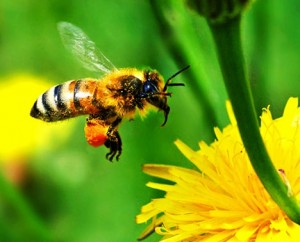 Honey bees like most insects not only have a brain in their head but several sub brains or
ganglia
(7 of these) spread throughout their bodies. There are 2 ganglia in the thorax and 5 in the abdomen. Ganglia function independently but can be controlled or over written by instructions from the main brain. They also send feedback to the main brain about the state of the environment in their particular area.
Honey bees like most insects not only have a brain in their head but several sub brains or
ganglia
(7 of these) spread throughout their bodies. There are 2 ganglia in the thorax and 5 in the abdomen. Ganglia function independently but can be controlled or over written by instructions from the main brain. They also send feedback to the main brain about the state of the environment in their particular area.
Most locomotion is controlled by the ganglia, not the brain and in fact a beheaded bee can move it’s legs and wings vigorously. A bee will be able to walk and sting for a while when decapitated, but not fly as its balance will be out without a head.
An adult honey bee is one of the most advanced insects and is capable of a huge range of different complex behaviour. Honey bees are capable of learning and have short-term memory.
The actual main brain of a an adult honey bee is proportionately very large in comparison with its size. In the worker bee the brain consists mainly of the optic lobes, with the central part acting as a coordinating centre and this central part is larger than in most other insects. Nerve fibres connect the brain to the 2 ganglia in the thorax and the 5 in tha abdomen.
Each ganglion has nerve fibres which connect it to sensory receptors on the outside of the body, to bring information back from the outside environment. The antennae are of course the main sites for sensory reception in the bee.
The ganglia also each have fibres which bring information about the condition of the internal organs of the bee and those which send back regulatory information. Fibres also carry information to the muscles to control their actions.
Much is still to be learned about why the bee is capable of displaying such complex behaviour in particular its amazing ability to navigate to and from its hive, remembering and passing on detailed information about the position of food sources.
More about Honey Bee Anatomy and Physiology

